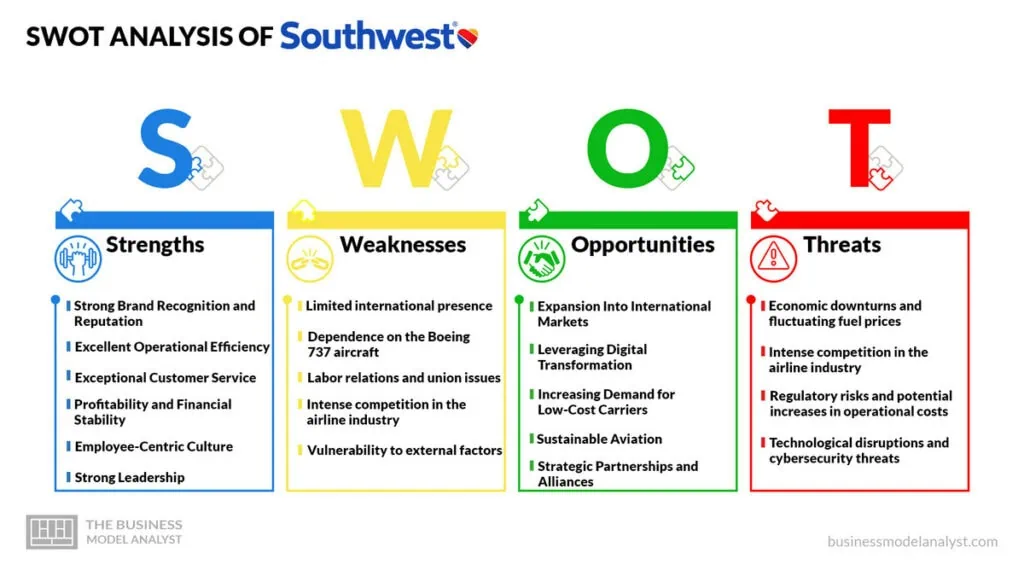Southwest Airlines, a major player in the airline industry, is known for its affordable fares, exemplary customer service, and unique business model. This Southwest Airlines SWOT analysis provides critical insight into the company’s strategies, operations, and market position, making it essential for stakeholders, investors, and competitors.
Southwest Airlines, founded in 1967 by Herb Kelleher and Rollin King, has transformed the aviation landscape with its low-cost, point-to-point service model. The company has consistently focused on maintaining low operating costs and delivering excellent customer service. This approach has resulted in strong brand loyalty and a solid market position, distinguishing Southwest from other airlines in the industry.
The company’s continuous efforts to expand its route network, enhance its fleet, and adopt innovative technologies have played a significant role in its success. However, Southwest Airlines also faces challenges, such as intense competition, fluctuating fuel prices, and regulatory issues, which can impact its growth and profitability.
This Southwest Airlines SWOT Analysis delves into the company’s core strengths, weaknesses, opportunities, and threats to comprehensively understand its competitive advantages and challenges.
Contents
Southwest Airlines Strengths
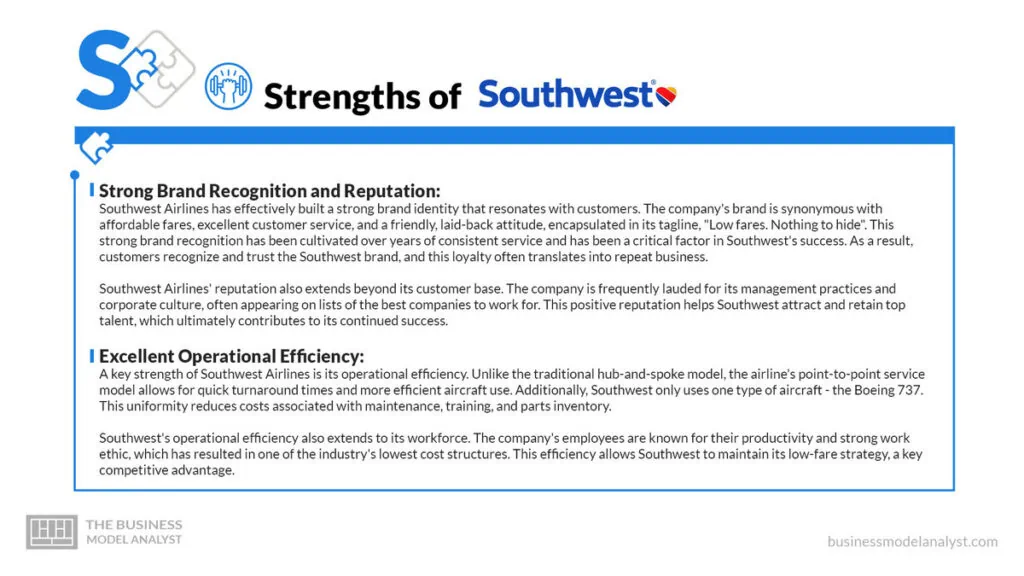
Strong Brand Recognition and Reputation
Southwest Airlines has effectively built a strong brand identity that resonates with customers. The company’s brand is synonymous with affordable fares, excellent customer service, and a friendly, laid-back attitude, encapsulated in its tagline, “Low fares. Nothing to hide”. This strong brand recognition has been cultivated over years of consistent service and has been a critical factor in Southwest’s success. As a result, customers recognize and trust the Southwest brand, and this loyalty often translates into repeat business.
Southwest Airlines’ reputation also extends beyond its customer base. The company is frequently lauded for its management practices and corporate culture, often appearing on lists of the best companies to work for. This positive reputation helps Southwest attract and retain top talent, which ultimately contributes to its continued success.
Excellent Operational Efficiency
A key strength of Southwest Airlines is its operational efficiency. Unlike the traditional hub-and-spoke model, the airline’s point-to-point service model allows for quick turnaround times and more efficient aircraft use. Additionally, Southwest only uses one type of aircraft – the Boeing 737. This uniformity reduces costs associated with maintenance, training, and parts inventory.
Southwest’s operational efficiency also extends to its workforce. The company’s employees are known for their productivity and strong work ethic, which has resulted in one of the industry’s lowest cost structures. This efficiency allows Southwest to maintain its low-fare strategy, a key competitive advantage.
Exceptional Customer Service
Southwest Airlines is renowned for its customer service. The company’s commitment to providing a positive customer experience is a core part of its business strategy and has been a significant factor in its success. Southwest’s employees are empowered to go the extra mile for customers, resulting in numerous stories of exceptional service that have enhanced the company’s reputation.
This focus on customer service extends to Southwest’s transparent pricing policy. For example, unlike many competitors, Southwest does not charge fees for checked bags or flight changes. This straightforward, customer-friendly approach has earned the airline a loyal customer base and has distinguished it in a highly competitive industry.
Profitability and Financial Stability
Southwest Airlines’ business model has allowed it to be profitable for over 40 consecutive years, a notable achievement in the volatile airline industry. The company’s focus on operational efficiency, cost control, and strong revenue generation has resulted in robust financial performance.
The company has a healthy balance sheet, with substantial cash reserves and manageable debt levels. This financial stability allows Southwest to invest in growth opportunities, weather economic downturns, and provide returns to shareholders. The airline’s strong financial performance and stability underscore its success and potential for future growth.
Employee-Centric Culture
Southwest Airlines is known for its unique, employee-centric corporate culture. The company firmly believes that happy employees lead to satisfied customers. As such, it invests significantly in employee training and development and fosters an environment of respect, transparency, and fun.
This employee-centric culture has resulted in high employee satisfaction and low turnover rates. Additionally, it has cultivated a strong sense of loyalty and camaraderie among employees, contributing to the airline’s high customer service and operational efficiency.
Strong Leadership
Southwest Airlines has benefited from strong, consistent leadership. The company’s co-founder, Herb Kelleher, is often credited with creating Southwest’s unique corporate culture and successful business model. The current leadership has continued to uphold Kelleher’s values and strategic vision, guiding the company through industry challenges and growth opportunities.
This strong leadership has provided stability and strategic direction for Southwest, contributing to its long-term success. It has also positioned the airline to navigate future industry challenges and capitalize on growth opportunities.
Sustainability Initiatives
Southwest Airlines is committed to sustainability, which is increasingly vital to today’s environmentally conscious consumers. The company has implemented various initiatives aimed at reducing its environmental impact, including investing in more fuel-efficient aircraft, implementing fuel-saving operational procedures, and supporting the development of sustainable aviation fuels.
Southwest’s commitment to sustainability not only helps reduce its environmental footprint but also enhances its reputation among customers, employees, and investors. This focus on sustainability can potentially provide Southwest with a competitive advantage as consumer preferences evolve and regulatory pressures increase.
Southwest Airlines Weaknesses
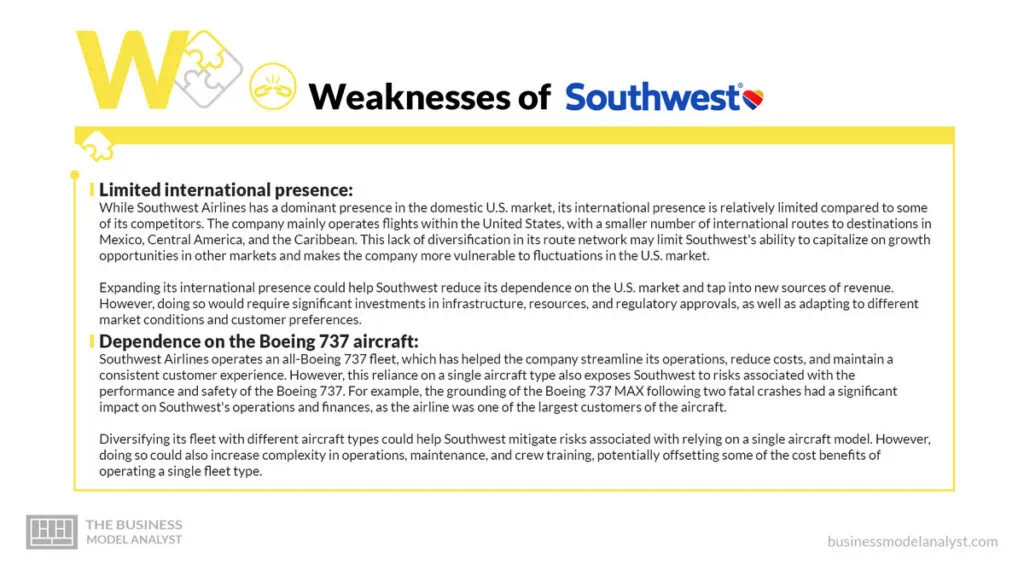
Limited international presence
While Southwest Airlines has a dominant presence in the domestic U.S. market, its international presence is relatively limited compared to some of its competitors. The company mainly operates flights within the United States, with a smaller number of international routes to destinations in Mexico, Central America, and the Caribbean. This lack of diversification in its route network may limit Southwest’s ability to capitalize on growth opportunities in other markets and makes the company more vulnerable to fluctuations in the U.S. market.
Expanding its international presence could help Southwest reduce its dependence on the U.S. market and tap into new sources of revenue. However, doing so would require significant investments in infrastructure, resources, and regulatory approvals, as well as adapting to different market conditions and customer preferences.
Dependence on the Boeing 737 aircraft
Southwest Airlines operates an all-Boeing 737 fleet, which has helped the company streamline its operations, reduce costs, and maintain a consistent customer experience. However, this reliance on a single aircraft type also exposes Southwest to risks associated with the performance and safety of the Boeing 737. For example, the grounding of the Boeing 737 MAX following two fatal crashes had a significant impact on Southwest’s operations and finances, as the airline was one of the largest customers of the aircraft.
Diversifying its fleet with different aircraft types could help Southwest mitigate risks associated with relying on a single aircraft model. However, doing so could also increase complexity in operations, maintenance, and crew training, potentially offsetting some of the cost benefits of operating a single fleet type.
Labor relations and union issues
As an airline with a large workforce, Southwest has experienced occasional labor disputes and union issues. These disputes can lead to operational disruptions, increased labor costs, and negative publicity for the company. Maintaining positive labor relations is crucial for Southwest to ensure smooth operations and maintain its reputation as an employer of choice.
Addressing labor concerns proactively and fostering a culture of collaboration and open communication can help Southwest minimize the risk of labor disputes and maintain a motivated and engaged workforce.
Intense competition in the airline industry
The airline industry is highly competitive, with numerous carriers vying for market share. Southwest faces competition from both legacy carriers, such as American Airlines and Delta, and low-cost carriers, such as Spirit Airlines and Frontier Airlines. This intense competition can lead to downward pressure on fares, which can impact Southwest’s profitability and market share.
To stay competitive in this challenging environment, Southwest needs to continue focusing on cost control, operational efficiency, and delivering a superior customer experience. Innovation in service offerings and exploring new revenue streams, such as ancillary services, can also help Southwest differentiate itself from its competitors.
Vulnerability to external factors
Like other airlines, Southwest is vulnerable to various external factors, including economic conditions, geopolitical events, and fluctuations in fuel prices. For example, economic downturns can lead to reduced demand for air travel, while geopolitical events can impact international travel and tourism. Similarly, volatility in fuel prices can have a significant impact on Southwest’s operating costs, as fuel is one of the most significant expenses for airlines.
While Southwest has implemented various measures to hedge against fuel price fluctuations and manage the impact of external factors on its business, the airline industry remains inherently vulnerable to these risks. Staying agile, focusing on cost control, and continuously adapting to changing market conditions can help Southwest navigate these challenges and maintain its competitive edge.
Potential impact of negative publicity
Southwest, like other airlines, is susceptible to the potential impact of negative publicity. Incidents such as customer service issues, labor disputes, or safety concerns can quickly garner media attention and harm the company’s reputation. In today’s digital age, negative news can spread rapidly through social media, potentially impacting customer perception and loyalty.
To mitigate the risk of negative publicity, Southwest needs to maintain high standards in customer service, safety, and operations. It also needs to have effective crisis management strategies in place to respond quickly and appropriately to any incidents that may occur. Transparency, swift action, and open communication can help manage such situations effectively and minimize their impact on the company’s reputation.
Southwest Airlines Opportunities
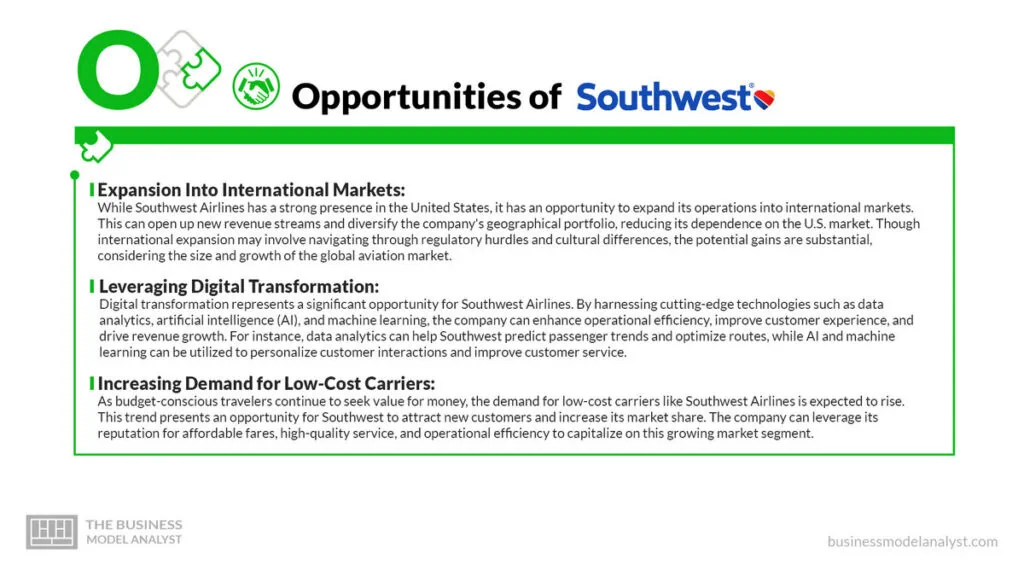
Expansion Into International Markets
While Southwest Airlines has a strong presence in the United States, it has an opportunity to expand its operations into international markets. This can open up new revenue streams and diversify the company’s geographical portfolio, reducing its dependence on the U.S. market. Though international expansion may involve navigating through regulatory hurdles and cultural differences, the potential gains are substantial, considering the size and growth of the global aviation market.
Leveraging Digital Transformation
Digital transformation represents a significant opportunity for Southwest Airlines. By harnessing cutting-edge technologies such as data analytics, artificial intelligence (AI), and machine learning, the company can enhance operational efficiency, improve customer experience, and drive revenue growth. For instance, data analytics can help Southwest predict passenger trends and optimize routes, while AI and machine learning can be utilized to personalize customer interactions and improve customer service.
Increasing Demand for Low-Cost Carriers
As budget-conscious travelers continue to seek value for money, the demand for low-cost carriers like Southwest Airlines is expected to rise. This trend presents an opportunity for Southwest to attract new customers and increase its market share. The company can leverage its reputation for affordable fares, high-quality service, and operational efficiency to capitalize on this growing market segment.
Sustainable Aviation
With increasing attention to climate change, there is a growing interest in sustainable aviation. Southwest Airlines can seize this opportunity by further investing in fuel-efficient aircraft, adopting sustainable aviation fuels, and implementing environmentally friendly practices. Such initiatives can not only reduce the company’s environmental footprint, but also enhance its brand image and appeal to eco-conscious customers and investors.
Strategic Partnerships and Alliances
Southwest Airlines can explore opportunities for strategic partnerships and alliances to expand its network, enhance its service offerings, and increase its customer base. Partnerships with other airlines can provide Southwest with access to new routes and markets. At the same time, alliances with hotels, car rental companies, and tourism boards can enhance the overall travel experience for its customers. These collaborations can help Southwest Airlines to provide more value to its customers, gain a competitive advantage, and drive growth.
Growth in the Cargo Business
The air cargo business is witnessing considerable growth, driven by the rise of e-commerce and the need for fast, reliable delivery of goods. Southwest Airlines can tap into this opportunity by expanding its cargo operations. This can provide an additional revenue stream and help the company to maximize the utilization of its existing fleet.
Diversification of Revenue Streams
While ticket sales form a significant portion of the airline’s revenue, Southwest has an opportunity to diversify its revenue streams. This could involve expanding ancillary services such as in-flight sales, baggage fees, or premium seating options. It could also explore non-aviation-related ventures, such as travel insurance or vacation packages. Such diversification can provide financial stability by mitigating risks associated with fluctuations in ticket sales.
Investment in Customer Service and Experience
In the highly competitive airline industry, customer service and experience can be key differentiators. Southwest Airlines has an opportunity to invest further in enhancing its customer service and in-flight experience. This could involve training and development for its customer service staff, improving in-flight amenities, or leveraging technology to simplify booking and check-in processes. These efforts can help to increase customer satisfaction, loyalty, and repeat business.
Developing Health and Safety Measures
In the wake of the COVID-19 pandemic, health and safety have become paramount considerations for travelers. Southwest Airlines has an opportunity to develop and implement robust health and safety measures to reassure passengers and encourage travel. This can involve regular deep cleaning of aircraft, enforcing mask policies, and implementing touchless procedures where possible. By prioritizing passenger health and safety, Southwest can build trust and confidence among its customers in the post-pandemic world.
Southwest Airlines Threats
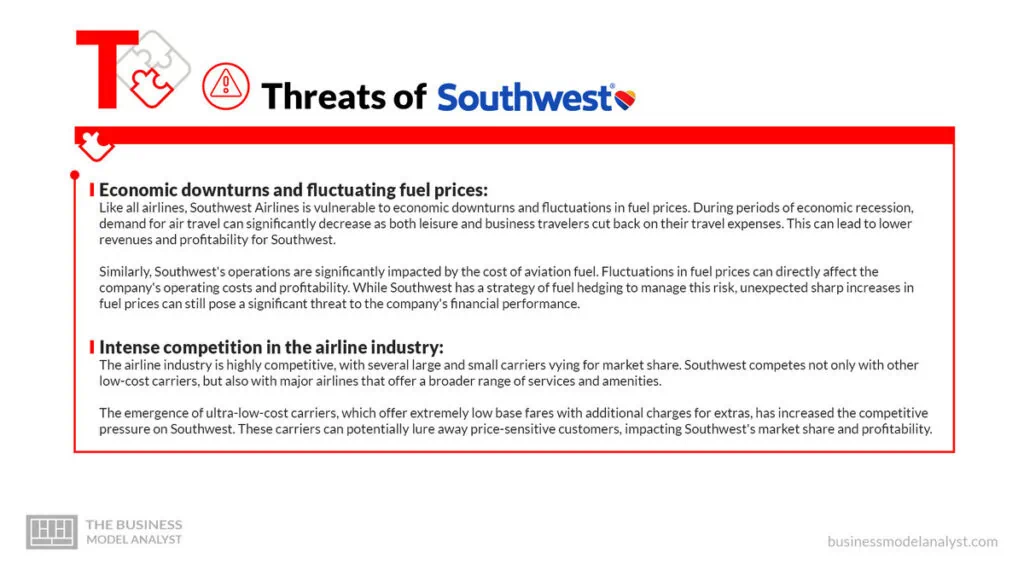
Economic downturns and fluctuating fuel prices
Like all airlines, Southwest Airlines is vulnerable to economic downturns and fluctuations in fuel prices. During periods of economic recession, demand for air travel can significantly decrease as both leisure and business travelers cut back on their travel expenses. This can lead to lower revenues and profitability for Southwest.
Similarly, Southwest’s operations are significantly impacted by the cost of aviation fuel. Fluctuations in fuel prices can directly affect the company’s operating costs and profitability. While Southwest has a strategy of fuel hedging to manage this risk, unexpected sharp increases in fuel prices can still pose a significant threat to the company’s financial performance.
Intense competition in the airline industry
The airline industry is highly competitive, with several large and small carriers vying for market share. Southwest competes not only with other low-cost carriers, but also with major airlines that offer a broader range of services and amenities.
The emergence of ultra-low-cost carriers, which offer extremely low base fares with additional charges for extras, has increased the competitive pressure on Southwest. These carriers can potentially lure away price-sensitive customers, impacting Southwest’s market share and profitability.
Regulatory risks and potential increases in operational costs
Southwest Airlines operates in a highly regulated environment, which can pose various risks. Changes in aviation regulations, environmental laws, or safety standards can lead to increased operational costs and affect the company’s profitability.
Furthermore, potential increases in airport fees, taxes, and labor costs also pose a threat to Southwest. The company’s ability to manage these costs and maintain its low-cost operating model is crucial for its long-term success.
Technological disruptions and cybersecurity threats
As the airline industry becomes increasingly digital, Southwest Airlines faces the risk of technological disruptions and cybersecurity threats. The company relies heavily on its IT systems for various functions, including ticket sales, flight operations, and customer service. Disruptions to these systems, whether due to technical issues or cyberattacks, can cause significant operational disruptions and harm the company’s reputation.
Moreover, the increasing prevalence of cyber threats poses a significant risk to Southwest. The company handles large volumes of sensitive customer data, and a data breach could lead to legal liabilities, financial losses, and damage to the company’s reputation.
Risks associated with climate change and environmental concerns
Climate change and increasing environmental concerns pose a significant threat to the airline industry. Airlines are under increasing pressure from regulators, investors, and consumers to reduce their environmental impact, particularly their carbon emissions.
While Southwest has taken steps towards sustainability, the company still faces potential risks. These include regulatory risks associated with potential carbon taxes or emissions trading schemes, operational risks associated with more frequent and severe weather events due to climate change, and reputational risks if the company is perceived as not doing enough to address its environmental impact.
Potential impacts of public health crises
The COVID-19 pandemic demonstrated the significant threat that public health crises can pose to airlines. The pandemic led to a dramatic decrease in air travel demand, causing significant financial losses for airlines, including Southwest. While the industry is recovering, future public health crises could have similar impacts.
Moreover, public health crises can also lead to increased operational costs due to increased health and safety measures. For example, Southwest has had to invest in enhanced cleaning procedures and protective equipment for its employees in response to the COVID-19 pandemic.
Conclusion
The Southwest Airlines SWOT analysis highlights the company’s numerous strengths, such as its low-cost business model, strong brand recognition, extensive route network, and commitment to sustainability. These strengths have allowed Southwest to become a significant player in the highly competitive airline industry and have contributed to its continued success.
However, the analysis also reveals weaknesses and potential threats that the company must address, including reliance on a single type of aircraft, vulnerability to fuel price fluctuations, and increasing competition. Southwest Airlines must continue to innovate and adapt to changing market conditions to maintain its competitive edge and capitalize on opportunities for growth.
By focusing on its core strengths and addressing its weaknesses and threats, Southwest Airlines can continue to thrive in the airline industry and deliver exceptional value to its customers, employees, and shareholders. Overall, the SWOT analysis serves as a valuable tool for understanding the company’s current position and potential future trajectory, providing insights that can help guide strategic decision-making for Southwest Airlines.


